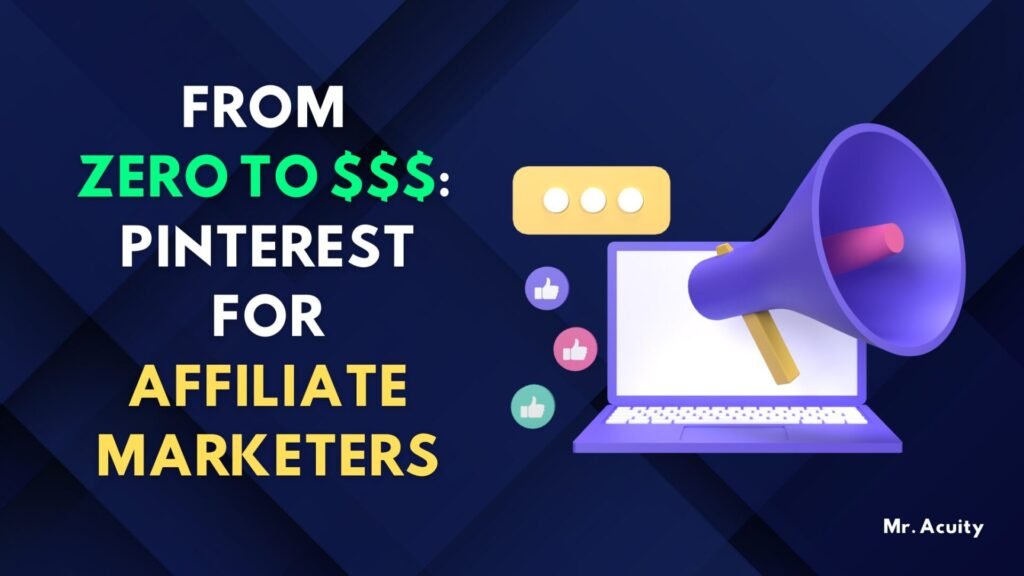Table of Contents
From Zero to $$$: Pinterest for Affiliate Marketers
Meet Sarah — a determined affiliate marketer who, like many, faced the formidable challenge of driving consistent, quality traffic to her offers without breaking the bank. Paid ads drained her budget, social media channels felt oversaturated, and SEO took months to gain traction. Then she discovered a game-changing platform: Pinterest. What started as a simple experiment became Sarah’s secret weapon for free, targeted traffic and steady affiliate revenue.
In this post, let’s dive into why Pinterest is such a powerful tool for affiliate marketers, how Sarah leveraged it to grow her business, and how you can implement this strategy step-by-step.
The Power of Pinterest for Affiliate Marketing
Pinterest is often misunderstood as “just another social media.” But in reality, it functions more like a visual search engine — with over 450 million active users seeking inspiration, ideas, and products daily. Here’s why it’s a golden opportunity for affiliate marketers:
- High Purchase Intent: Pinterest users aren’t just browsing; they’re actively planning purchases, looking for solutions, and open to recommendations.
- Evergreen Content Lifespan: Unlike fleeting posts on Instagram or Twitter, pins can drive traffic for months or even years.
- Low Competition for Niches: Many affiliate marketers underestimate Pinterest, making it easier to carve out space if you understand the algorithm and trends.
- Visual Storytelling: Pinterest lets you tap into storytelling through images that captivate users and lead naturally to clicks on your affiliate links.
Sarah quickly realized that Pinterest was driving traffic to her affiliate offers on health supplements, DIY crafts, and home décor — niches that thrive visually and align perfectly with Pinterest’s audience.
How Sarah Harnessed Pinterest’s Free Traffic
1. Niche-Specific Content Creation
Sarah focused on creating pins tailored to her niche keywords. She researched trending topics and popular searches using Pinterest’s own search bar and tools like Pinterest Trends. For example, for health supplements, she created infographics highlighting benefits, step-by-step guides for healthy habits, and product review pins.
2. Designing Click-Worthy Pins
Visual appeal is crucial. Sarah used tools like Canva to design pins with bold fonts, contrasting colors, and clean layouts. She made sure every pin had a compelling title overlay to entice clicks.
3. Consistent Pinning Schedule
Pinterest’s algorithm favors consistency. Sarah committed to pinning 10-15 pins daily, mixing her own content with repins in her niche, thereby staying active and visible.
4. SEO Optimization for Pinterest
Just like Google, Pinterest is a search engine. Sarah optimized her pin descriptions with relevant keywords, hashtags, and a clear call-to-action (CTA). She also created multiple boards focused on specific affiliate niches to increase the likelihood of discovery.
5. Tracking and Analytics
Using Pinterest Analytics and URL tracking tools (like Bitly or UTM parameters), Sarah monitored which pins drove the most traffic and conversions. This data helped her double down on successful strategies.
Bonus: What Every Affiliate Marketer Should Explore?
- Understanding Pinterest Algorithm: Dive deeper into how and why certain pins get prioritized.
- Diversifying Affiliate Traffic Sources: While Pinterest was powerful for Sarah, combining it with email lists and SEO enhances sustainability.
- Compliance and Affiliate Disclosure: Ensuring compliance with Pinterest’s policies and FTC guidelines when posting affiliate links.
- Leveraging Group Boards and Tailwind Tribes: Collaborate with other pinners to amplify reach.
- Using Video Pins: The rising trend of video content on Pinterest can boost engagement.
Final Thoughts
Sarah’s journey illustrates an essential truth: affiliate marketing isn’t just about links and products — it’s about connecting authentically with an audience through the right platform. Pinterest turned her frustrations into freedom, providing not only free traffic but a scalable and sustainable business model.
If you’re an affiliate marketer tired of the same old traffic sources, dive into Pinterest with passion, creativity, and strategy. Your ideal audience is already there — ready to discover what only you can offer.
Inspired to get started?
Create your Pinterest business account today, and start crafting pins that tell your affiliate story. Remember, every click is a new connection — and every connection is a potential customer.
